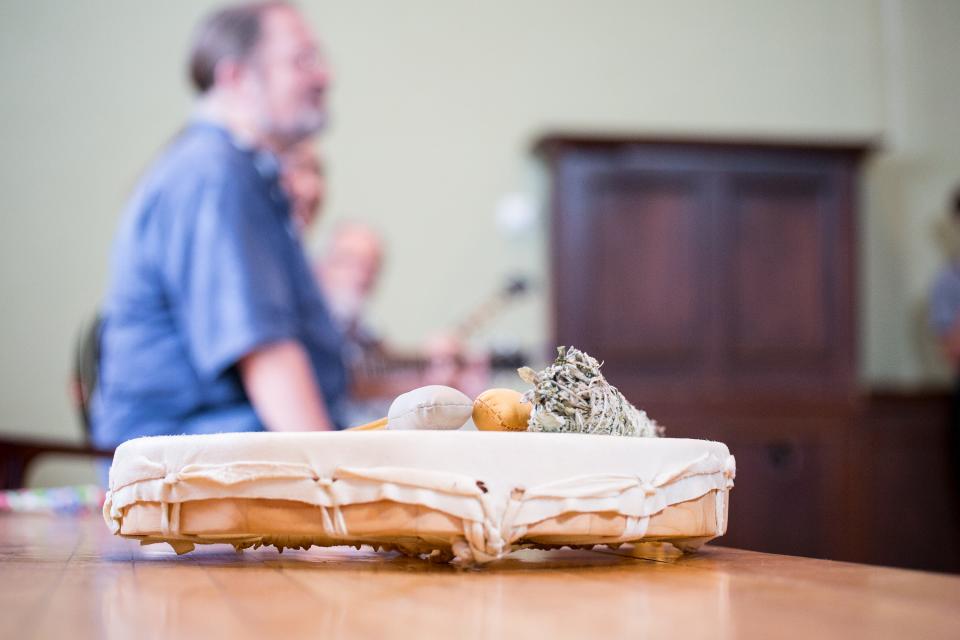As Canadians continue to grapple with the legacy of the residential schools, denominations, churches and seminaries across the country are considering what it means to live into the Calls to Action coming out of the Truth and Reconciliation Commission (TRC). Many of those Calls will have implications for ministry and mission now and in the coming generations, with some specifically referencing seminaries.
On Friday, March 9, 2018, Wycliffe Principal Stephen Andrews, together with five colleagues from the Toronto School of Theology and its member colleges—Alan Hayes (TST), Chris Brittain (Trinity), James Ginther (St. Michael’s), Gordon Rixon (Regis), and John Vissers (Knox)—travelled to Sault Ste. Marie’s Algoma University, to explore the best ways of responding to the TRC’s Calls to Action. Principal Andrews (SA) responds below to questions about their visit.
Q: Why Algoma University?
SA: Algoma University has a special mission as a teaching-oriented, primarily undergraduate university, focused on the needs of Northern Ontario. Part of its unique mission is to cultivate cross-cultural learning between indigenous communities and other communities, in keeping with the history of Algoma University College and its geographic site.
It also happens to be my old haunt. Before coming to Wycliffe, I served as the Bishop of Algoma. I lived in the Sault, so I know some of the people at the university well.
Algoma University has a partnership with an Anishnaabe educational institution, the Shingwauk Kinoomaage Gamig. I knew that they were trying to work out a joint program, so we thought it would be important to try to learn from them, from their successes and failures, and how they are going about the business of providing higher education for Indigenous people.
Q: How were you received?
SA: We were very graciously received by Algoma University. They pulled out all the stops and were very generous with their time. We visited the Residential Schools Centre. Algoma has the premier residential schools archives apart from the TRC archive. It is an amazing repository of photographs and stories. We had a tour of the campus, which included the chapel and the cemetery where a number of the child victims of the residential schools are buried. That opened our eyes to the legacy of the residential schools in a very personal and deeply moving way. They talked about how difficult it is for many of the survivors to come back and visit—the university is located on the site of the former residential school, and they’ve preserved two of the original buildings—so just inhabiting that space means people are always reminded of the school's legacy.
Our visit was shaped by Dr. Celia Ross, the former president of Algoma University. Following our visit of the Residential School Centre, we met with the new president, Asima Vezina. She told us about her initial experiences with the Calls to Action and how they’re thinking of responding to them in the university. She has written a paper called “Algoma University Statement on Truth and Reconciliation: Calls to Action and Beyond”. She humbly told us she came in to her role just over four months ago thinking she knew what would be required, and has learned that she knew nothing.
Our day included meetings with faculty, including Indigenous teachers, who led us in meaningful discussions and broadened our understanding of Indigenous experiences.
Q: How will responding to these Calls to Action transform the way we do academics and the way we do church?
SA: The answer to this depends to some extent on how we respond to the Calls. But the consequences could be far-reaching. Our syllabi could be modified to include, where appropriate, a fuller description of our history with indigenous people and the impact of racism and colonialism. Indigenous voices in our readings and in our classes would also introduce us to new perspectives, on, say, the land, tribal life and the place of orality, which would deepen our understanding of the Scriptures, theology and the nature of community. We would also be exposed to new ways of learning. We are already looking at partnerships with indigenous learning communities. Taking the Calls seriously could eventually lead to the hiring of indigenous faculty and the development of an indigenous curriculum.
Now, this may not have any direct significance for the indigenous church, but it would give us all a better foundation on which to build reconciliation, and make us better partners in the quest of the Anglican Council of Indigenous Peoples for self-determination.
Q: What hopeful signs do you see for the future of the church, in light of your learning last week?
SA: I was encouraged by the commitment of those around the table to learn more about the residential schools legacy and indigenous culture. I always come away from these sorts of engagements humbled, and I think that this was shared by my colleagues. We have so far to go in our understanding, and we need to resist the temptation to think that we know what it is like to be an indigenous person in Canada or that we know how best to address the challenges that face our ecclesiastical communities. We could use more humility in the Church! To me, humility and hope are in a proportional relationship.





